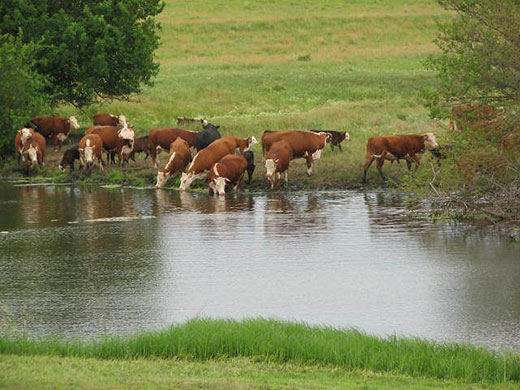
Ponds can provide a great water source for cattle in the summer but they must be monitored for the presence of blue-green algae. | Download this photo.
Blue-green algae presents dangers to livestock
K-State expert cautions stagnant water can lead to toxic blooms in watering ponds
July 21, 2020
MANHATTAN, Kan. — Water is critical to the survival of all living creatures, but if that water source is compromised, it can have deadly consequences.
For cattle ranchers, watering their livestock from ponds and the presence of high amounts of blue-green algae can be a threat, said Scott Fritz, toxicology resident with the Kansas State University Veterinary Diagnostic lab.
“It is common when we look at case histories to see a sudden, overnight death associated with blue-green algae,” Fritz said during a recent Cattle Chat podcast with the experts at the Beef Cattle Institute.
To avoid this tragedy, Fritz said cattle ranchers need to monitor the ponds that cattle drink from, especially in late summer.
“Blue-green algae are present in every body of water and they are an important part of the ecosystem. However, in mid-summer the water can become stagnant when the rain tapers off, and that is when the algae will rapidly bloom,” Fritz said. When those algae blooms start to die, toxins are released.
He said there are visual cues that ranchers can watch for when monitoring the ponds.
“You’ll first see what looks like pond scum on the top of the water. It can be blue, green or orange,” Fritz said. “Any time the pond looks a little different, it is important to get it tested.”
To test the water, Fritz said producers should collect a sample by using a container, jar or old water bottle.
“The blooms are buoyant, so on a windy day they tend to drift to one side of the pond and that is a great place to make the collection,” Fritz said. He recommended that when ranchers collect a sample, they should try to gather water a few inches below the surface.
When the samples arrive at the lab, they are evaluated under a microscope for the presence of algae. If algae are present then the scientists do follow up testing to determine how much toxin is concentrated, he said.
Fritz has observed that blooms are becoming more common and can occur more than once in a summer on an individual pond, which is why monitoring is important. He also said that cattle can be given access to the pond once it is determined through testing that it is safe.
“It isn’t economically practical to keep cattle off pastures for years, so the best thing producers can do is monitor the ponds. Once the blooms are gone and the toxins are no longer present, it is safe to put the cows back out there provided the water is going to continue to be monitored,” Fritz said.
To learn more about this topic or for resources about managing blue-green algae, visit http://www.ksvdl.org/laboratories/toxicology/
To hear the full discussion regarding blue-green algae listen to the BCI Cattle Chat podcast online.

